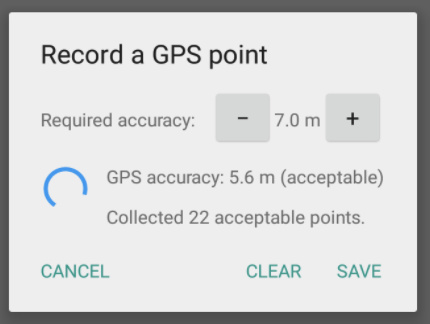Hi LN,
I strongly support your suggestion to add number of satellites connected/expected.
Time to fix would be nice if it worked well, but I suspect it'll be hard to make that estimate realistic, and I'd just as soon not have it than have an estimated time to fix that's usually wrong. I'd be interested to see how well it can be made to work, but I'm not optimistic!
As you say, often our surveyors in the field find themselves staring at a Waiting for GPS fix dialogue, which is frustrating and uninformative; there's no real way to know if there's progress being made or not. Our field workers do as you describe above; they exit ODK, open another application (GPS Essentials, OSMAND, or the like) that provides at least a number of satellites connected/expected, if not a skyplot etc. Once they have a fix, they return to ODK. If not - if they are seeing 0/0 for a few minutes - they know to troubleshoot or request help. This app-switching works, but of course it would be far nicer to have the information right in ODK.
Yes, @zestyping implemented an averaged-point system with a variable filter at our request, which our field team is using here in Tanzania.
We allow users to control the required accuracy simply because they can then select the lowest threshold at which they can practically collect an adequate number of points! For example, if the threshold is fixed at 4.0 m, and the GPS is sitting at 5.6 for 30 minutes, it is probably not reasonable to continue waiting; in our case it's more sensible to raise the threshold to 6, accept the points (and maybe collect a higher number to average), and move on. If, on the other hand, your GPS has a really tight fix, you might as well lower the filter threshold to keep only the most accurate points. So user control of the threshold works well for us in the field.
This filtering could, of course, be done in post-processing, but only if we kept all of the points (which would be a pretty major change to the way ODK stores information). Alternately, we could weight the lower-precision points less in the average, but this still leaves us with a conundrum when we have a location where we just can't get very good precision. We'd rather the user make a (hopefully informed) decision about whether to collect the point or not than hide the details behind some kind of weighting.
I haven't got a lot of empirical evidence that averaging points improves accuracy, but I suspect it does based on experience, some reading, and some mathematical reasoning. When I have time, I'm going to run some proper tests on this to determine if it improves accuracy in real-world African surveying conditions.
I was in Canadian forestry back in the late Pleistocene (well, the 1990's), and we used what were at the time very expensive Trimble survey-grade GPS machines (giant pole-mounted overhead antenna sticking out of a backpack and a vest full of lead-acid battery packs; ah, the good old days). These GPS machines actually used point averaging by default; when setting up a survey you could specify a number of points required for a given type of feature; I seem to recall that the default setting was something like 10 points. If you wanted more accuracy, you added more points to the pool to average. Government clients would specify a number of averaged fixes per location in their contracts with surveyors. I have no idea if that was actually evidence-based, but it was certainly the standard practice, and someone must have thought it improved accuracy.
Reasoning from first principles, it seems as though averaging points should reduce any error resulting from stochastic atmospheric diffraction and timing slop in the receiver; those will follow a Gaussian normal distribution. It won't help for multipath error or poor satellite geometry (persistent diffraction where one or more birds are low on the horizon and their signals are passing through a lot of air); those errors are biased, not Gaussian, and the only mitigation I'm aware of is Differential GPS correction. DGPS itself is far out of scope, though it's possibly worth considering if logging satellite information for each point someday in the future would be very expensive; it would enable us to play with DGPS possibilities). I'd guess that if you waited long enough at each point, even those errors would eventually approach a Gaussian distribution (as the satellite constellation changes); there are occasional use-cases for which you actually do want to leave the phone at a single location for the whole day to get a really precise point.
This seems to be the general consensus on the thread you posted, LN, as well as most of the reading I've done (I've read a lot about this since I've long been mildly obsessed with using smartphones for the highest-possible-precision surveying so that we can scale mapping and health activities in Africa using local devices).
I'd be keen indeed to hear more from the geo experts!
Ivan
